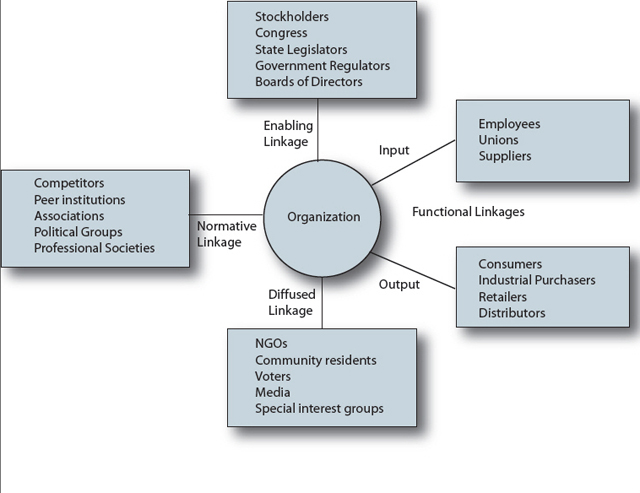This is “Stakeholder Management and Prioritizing Publics”, section 7.1 from the book Public Relations (v. 1.0). For details on it (including licensing), click here.
For more information on the source of this book, or why it is available for free, please see the project's home page. You can browse or download additional books there. To download a .zip file containing this book to use offline, simply click here.
7.1 Stakeholder Management and Prioritizing Publics
Experts in stakeholder management and public relations have provided many different ways of identifying key stakeholders or publics. At the heart of these attempts is the question, “How much attention does each stakeholder group deserve or require?”This section is revised with permission from Rawlins (2006).
Because it is impossible that all stakeholders will have the same interests in and demands on the organization, Winn specified that stakeholder management be about managing stakeholders’ potentially conflicting interests.Winn (2001), pp. 133–166. Once organizations have identified their stakeholders, there is a struggle for attention: who to give it to, who to give more to, and who to ignore. Sacrificing the needs of one stakeholder for the needs of the other is a dilemma with which many organizations struggle. When these conflicts arise it is important to the success of the organization that it has prioritized each stakeholder according to the situation.
This chapter will provide a model that moves from the broadest attempts at identifying all stakeholders, to the more specific need of identifying key publics for communication strategies. The model is situational, and priority of stakeholders and publics will change according to the situation.
Defining Stakeholders and Publics
A stakeholderA group or an individual who is affected by or who can affect the success of an organization, such as employees, customers, shareholders, communities, and suppliers. is a group or individual who is affected by or can affect the success of an organization.Freeman (1984). The definition has been expanded to include groups who have interests in the corporation, regardless of the corporation’s interest in them. Employees, customers, shareholders, communities, and suppliers are those most commonly classified as stakeholders within an organization
Grunig and Repper differentiated the terms “stakeholder” and “public” in the following way: Organizations choose stakeholders by their marketing strategies, recruiting, and investment plans, but “publics arise on their own and choose the organization for attention.”Grunig and Repper (1992), p. 128. This classification relied on John Dewey’s definition of a public: That it is a group of people who face a similar problem, recognize the problem, and organize themselves to do something about it.Dewey (1927). Therefore, publics organize from the ranks of stakeholders when they recognize an issue and act upon it.
Stakeholder Linkages to the Organization
Organization should attempt to identify all stakeholders before narrowing them by their attributes. One way to do this is by considering how these groups are linked to the organization. A model by Grunig and Hunt breaks these links into four groups by linkage: enabling, functional, diffused, and normative stakeholders (see Figure 7.1 "Grunig’s Organizational Linkage Model").Grunig and Hunt (1984). Grunig and Hunt developed the model based on the work of Esman (1972); Evan (1976); Parsons (1976).
- Enabling stakeholdersStakeholders who have some control and authority over an organization, such as stockholders, board of directors, elected officials, and governmental legislators and regulators. have some control and authority over the organization, such as stockholders, board of directors, elected officials, governmental legislators and regulators, and so on. These stakeholders provide an organization with resources and necessary levels of autonomy to operate. When enabling relationships falter, the resources can be withdrawn and the autonomy of the organization limited, restricted, or regulated.
- Functional stakeholdersStakeholders who are essential to the operations of an organization. Functional stakeholders are categorized as being part of the input by providing labor and resources to create products or services, or as part of the output by receiving those products or services. are essential to the operations of the organization and are divided between input—providing labor and resources to create products or services (such as employees and suppliers)—and output—receiving the products or services (such as consumers and retailers).
- Normative stakeholdersStakeholders who share a common interest with an organization. These associations or groups share similar values, goals, or problems. are associations or groups with which the organization has a common interest. These stakeholders share similar values, goals, or problems and often include competitors that belong to industrial or professional associations.
- Diffused stakeholdersStakeholders, including publics, who have infrequent interactions with an organization. They become involved with an organization based on the actions of the organization. are the most difficult to identify because they include publics who have infrequent interaction with the organization, and become involved based on the actions of the organization. These are the publics that often arise in times of a crisis; linkages include the media, the community, activists, and other special interest groups.
Going through the linkage model should help an organization identify all its stakeholders. The diffused linkage stakeholders would be different according to situation, but the enabling, functional, and normative linkage stakeholders are likely to be constant.
Figure 7.1 Grunig’s Organizational Linkage Model

Source: Rawlins (2006) adapted and used with permission from Grunig.




